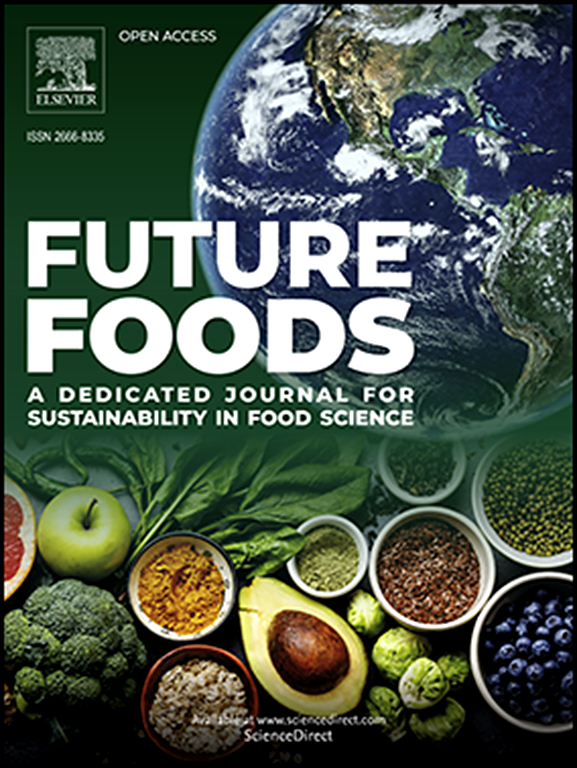Brewers’ spent grain as a functional ingredient in bakery, pasta, and cereal-based products
IF 7.2
Q1 FOOD SCIENCE & TECHNOLOGY
引用次数: 0
Abstract
The food industry by-product causes a negative environmental impact and reduces resource efficiency and productivity. Although these by-products have been used only for animal feed purposes in the past, there is an emerging trend to use them in human food as well. Brewers’ spent grain (BSG) is a proper example of such industrial by-products; it constitutes about 85 % of the total by-products generated in the brewing industry. With high amounts of fiber and protein, BSG can serve as a formulation ingredient in human nutrition. Accordingly, many studies have tried to investigate the possibility of using it in different food products. Overall, BSG is a promising source of bioactive compounds with antioxidant, antidiabetic, anti-inflammatory, and antithrombotic properties. Enzymatic hydrolysis, fermentation, and extraction conditions can be optimized to enhance the functional attributes of BSG for food, pharmaceutical, and nutraceutical applications. This review elaborated on the possibility of using BSG within bakery, pasta, and cereal-based formulations and its effect on such products' quality and nutritional characteristics. In addition, the functional ingredients of BSG and their biological properties are briefly reviewed. The research results suggest that incorporating BSG into various bakery products can enhance their nutritional value, but the optimal level of addition varies depending on the specific product. Careful optimization is required to balance an improved nutritional profile and acceptable technological and sensory qualities. However, the challenge facing the high-scale utilization of BSG ingredients is the variability of raw material composition. Therefore, more study is needed to develop innovative technologies for integrated and comprehensive valorization of BSG.

酿酒师用过的谷物作为烘焙、面食和谷物类产品的功能性配料
食品工业副产品会对环境造成负面影响,并降低资源效率和生产力。虽然这些副产品过去只用于动物饲料,但现在出现了将其用于人类食品的趋势。酿酒师用过的谷物(BSG)就是此类工业副产品的一个典型例子;它约占酿酒业产生的副产品总量的 85%。BSG 含有大量纤维和蛋白质,可作为人类营养的配方成分。因此,许多研究都试图探讨在不同食品中使用 BSG 的可能性。总之,BSG 是一种很有前景的生物活性化合物来源,具有抗氧化、抗糖尿病、抗炎和抗血栓等特性。可以优化酶水解、发酵和提取条件,以提高 BSG 在食品、药品和营养品应用中的功能属性。本综述阐述了在烘焙食品、面食和谷物制剂中使用 BSG 的可能性及其对此类产品的质量和营养特性的影响。此外,还简要回顾了 BSG 的功能成分及其生物特性。研究结果表明,在各种烘焙产品中添加 BSG 可提高其营养价值,但最佳添加量因具体产品而异。要在改善营养成分与可接受的技术和感官质量之间取得平衡,就必须进行仔细的优化。然而,大规模利用 BSG 配料所面临的挑战是原料成分的多变性。因此,需要开展更多研究,以开发创新技术,实现 BSG 的综合和全面增值。
本文章由计算机程序翻译,如有差异,请以英文原文为准。
求助全文
约1分钟内获得全文
求助全文
来源期刊

Future Foods
Agricultural and Biological Sciences-Food Science
CiteScore
8.60
自引率
0.00%
发文量
97
审稿时长
15 weeks
期刊介绍:
Future Foods is a specialized journal that is dedicated to tackling the challenges posed by climate change and the need for sustainability in the realm of food production. The journal recognizes the imperative to transform current food manufacturing and consumption practices to meet the dietary needs of a burgeoning global population while simultaneously curbing environmental degradation.
The mission of Future Foods is to disseminate research that aligns with the goal of fostering the development of innovative technologies and alternative food sources to establish more sustainable food systems. The journal is committed to publishing high-quality, peer-reviewed articles that contribute to the advancement of sustainable food practices.
Abstracting and indexing:
Scopus
Directory of Open Access Journals (DOAJ)
Emerging Sources Citation Index (ESCI)
SCImago Journal Rank (SJR)
SNIP
 求助内容:
求助内容: 应助结果提醒方式:
应助结果提醒方式:


